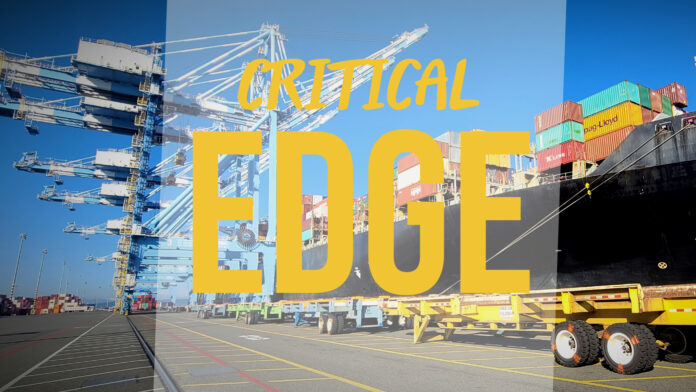The edge has always existed, as any bull-headed IT wizard will tell you; but it has not always existed like this. The edge-cloud continuum is well travelled by enterprise IT technicians, taking powerful advantage of the economies of hyper-scale afforded by cloud-based compute engines. But the other side of the global economy, engaged at the coal-face of production in all types of hard-nosed industrial segments, have kept things locked down. In the clank and boom of Industry 4.0, hardly anything goes to the cloud. More than this, most of it doesn’t leave its station at all.
But this is changing, according to Finnish telecoms vendor Nokia, grinding through the gears in the developing Industry 4.0 space with a well-worked edge networking proposition and well-placed edge computing system. And it is not that the paranoid control freaks of global industry are wilfully opening direct lines to centralised public data centres; they will never use the cloud in this way, the story goes. Instead, it is that they are disentangling the chaos of legacy compute systems into pristine edge server arrays – bankrolled, ostensibly, to run private cellular networks.

There is a lot to unpack, right? But the message from Nokia is that private 5G (etc) is affording enterprises a complete rethink of operating technology (OT) infrastructure, extending beyond just the network to also include the mish-mash of proprietary closed-shop embedded computing systems that have largely controlled the industrial economy until now. Of course, Nokia has something to sell – a twin edge network-and-compute bundle for the factory floor. But its logic is interesting, and makes sense.
Stephane Daeuble, in charge of enterprise solutions marketing at the firm, explains: “You know why it’s changing? It is changing because of private wireless. Before you had no choice but to run your compute inside your machines – because you couldn’t rely on the network. The difference now is you have reliable wireless connectivity, and reliable throughput and latency. So the question is: do you need 2,000 legacy compute elements inside your machines inside your plant – or can you trust cellular enough to start to bring all of them together?”
He goes on: “And you don’t need 20 blades for that – with one for the management system, one for the voice network, one for the gate system, one for the video cameras. You just have one blade, or one reliable blade stack, to run it all – and also to orchestrate [the whole OT system] at the edge. Which is brilliant simplicity – compared with the alternative complexity to run all these disconnected and unconnected industrial PCs.” The theory is to reinvent the industrial edge, where OT lives, whilst annexing the cloud also for opportunistic crunching of sanitised OT data.
It explains Nokia’s own strategic shift to make its digital automation cloud (DAC) product, for private networking, a function of an even more ambitious mission-critical industrial edge (MXIE) server-and-software venture. It wants to make MXIE into an Industry 4.0 orchestration hub, between ‘southbound’ industrial OT machines and ‘northbound’ enterprise IT systems, connected (preferably but not exclusively) on private LTE and 5G networks, with outbound public/private cloud systems mapped in as well for certain management and analytics functions.
But we can park all of that; Nokia’s agenda is important to know, but the jeopardy and opportunity it sees in the industrial market is more interesting. Daeuble says: “These industrial plants are a mess – so far as the compute goes. Most of the time the data stays in the machine because the machine is not connected; the data is not extracted, so its value is not realised. And there are legacy units everywhere, in all shapes and forms. You enter into these environments like it is the 1980s – versus the IT world which has already moved to the cloud, or cloud-edge.”
He explains why industrial outfits want sensitive operational data to stay on-site: control and reliability, speed and performance, security and sovereignty – as per the standard justification for private cellular as a means to deterministic networking. He also offers up an example of how private 5G is working like a Trojan Horse, in ways, to get Nokia through the gate to discuss the whole edge architecture with enterprises; the company is working with a major port operator to flush its mid-sized operations with LTE networks.
Daeuble explains: “We have deployed in 20 ports with one customer, going from big-sized ports into mid-sized ones. And the private wireless network is delivering an amazing experience, but the TOS (terminal operating system) is in the cloud – because these sites are not big enough to justify an edge server to run it. And it has been a massive issue for the customer. They have fixed the network reliability, but the TOS is not responding fast enough because the distance to the cloud messes with the latency – to the point sometimes the whole site stops.
“But the DAC network gives them a MXIE blade, right, and so the customer asked to move the TOS onto the MXIE system. There are a few technical things to fix, but that is the way it is going. Without the edge network, the business case for the edge compute does not work. Which also tells you something about the economic challenges sometimes to run OT data in the cloud. But the whole basis of the MXIE proposition is that this critical-grade compute blade is already there – to run the core network – and all the OT data is going through that core anyway.”
The other advantage, he reckons, is it makes the business case for ultra reliability – as specified in the original ultra-reliable low-latency (URLLC) development work for cellular 5G technology, and as hyped-to-death ever after – easier within the total edge system. As others have argued very well, the pursuit of so-called ‘five-nines’ or ‘six-nines’ (99.999 percent or 99.9999 percent) reliability tends to come unstuck when the final bill is presented – just because, as a glib rule-of-thumb (as good as any), ‘every extra nine costs an extra zero’.
Daeuble says: “Yes, there’s a high cost for every nine. Which is the other reason this 5G-OT edge is in the picture – because there is no point adding an OT edge to a Wi-Fi network which gives you three-nines, at best. Now with private cellular, you have four or five in the network. So the other reason not to go to the cloud, actually, is so you don’t compromise that. It is fine for IT by the way, because the IT network is three, and the cloud is three – four max, if you do things well. But now you’ve got private 5G, going to five-nines, which you can hook your OT edge to.”
He adds: “You have a better car and a better road. Whereas before, well it was just bumpier – because the cloud was a long way away, and because your Wi-Fi was sh*tty.” Ahem.
For more on this topic, tune in to the upcoming webinar on Critical 5G Edge Workloads on September 27 – with ABI Research, Kyndryl, Southern California Edison, and Volt Active Data.
All entries in the Postcards from the Edge series are available below.
Postcards from the edge | Compute is critical, 5G is useful (sometimes) – says NTT
Postcards from the edge | Cloud is (quite) secure, edge is not (always) – says Factry
Postcards from the edge | Rules-of-thumb for critical Industry 4.0 workloads – by Kyndryl
Postcards from the edge | No single recipe for Industry 4.0 success – says PwC
Postcards from the edge | Ultra (‘six nines’) reliability – and why it’s madness (Reader Forum)
Postcards from the edge | Private 5G is reshaping the Industry 4.0 edge, says Nokia

